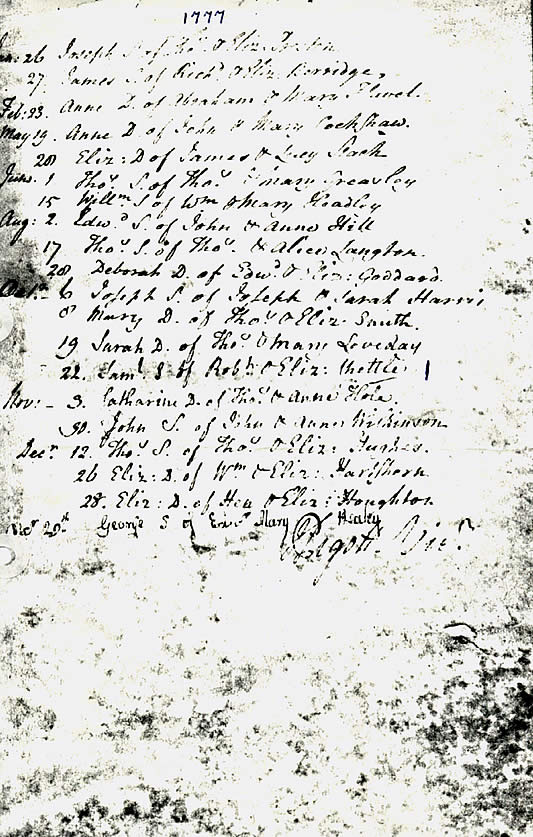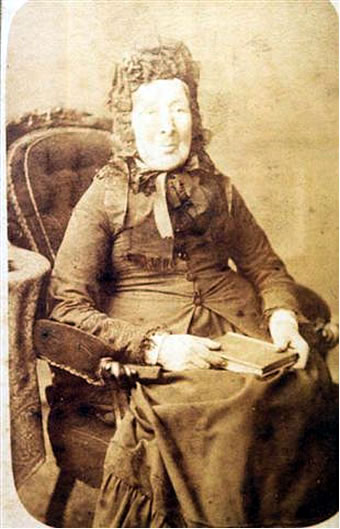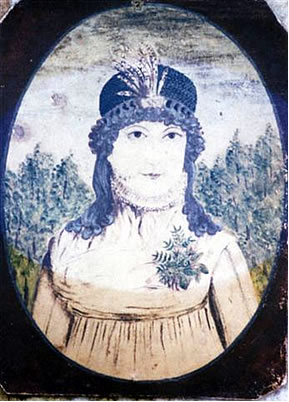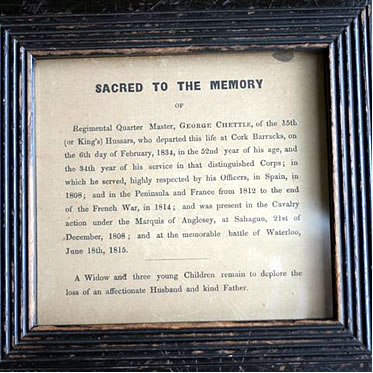 |
Family 4: Family of Robert Chettle
Baptism - 1741, Robert Chettle, Son of Robert & Elizabeth
Marriage - 176?, Robert Chettle & Elizabeth Ratcliffe.
Trade - Woolcomber
Home - Leicester, St Nicholas Parish, then All Saints Parish (Northgate Street).
Apprentice - 13 April 1757 Robert Chettle Son of Robert (Gardener) to Thos. Dyson.
(Woolcomber)
Freeman - 20 Aug 1767 Robert Chettle Apprentice of Thos Dyson of Leicester,
Dyer (Deceased). Also made Free on the same day was Samuel Shipley
(Roberts Great Grandfather)
Children of Robert & Elizabeth (St Nicholas)
Baptism 9 Aug 1768* - Robert Ratcliffe Chettle - Buried
Baptism 8 Aug 1769 - Elizabeth Chettle (Married John Jarvis 11 Oct 1791 All Saints)
Baptism - Francis Tomlinson Chettle - Buried
Baptism 9 Jan 1772 - John Chettle - Buried
Baptism 14 Nov 1773 - Dinah Chettle - Buried
Baptism 21 Jan 1776 - Thomas Chettle - Buried
Baptism 22 Oct 1777* - Samuel Chettle - Buried
Baptism 4 Feb 1780 - Sarah Chettle - Buried 7 July 1781 (Al Saints)
Baptism 20 Nov 1781 - William Chettle (Born 19 Nov 1781) (Infant Death)
Baptism 1 Jan 1783 - George Rodney Chettle (Born 18 Dec 1782, All Saints)
Baptism 7 April 1785 - William Chettle (Born 29 Mar 185) - Buried 27 Jan 1786 (All Saints)
Baptism 26 Feb 1789 - Mary Chettle (All Saints) Married John Monk 25 Dec 1807 at
St Margarets Church Leicester.
Baptism 12 May 1790 - William Chettle (All Saints) - Buried 3 Sept 1790
Baptism 26 Dec 1791 - Hannah Chettle (All Saints) - Buried 29 Dec 1791 (All Saints)
Burial: 16 May 1813 Elizabeth Chettle aged 66 All Saints Church.
Burial: 28 Nov 1813 Robert Chettle aged 72 All Saints Church.
*Our line continues with Samuel Chettle
We know of Francis Tomlinson Chettle by way of the Freemans List: - 23 Feb 1789 also on the Freemans List; Robert Ratcliffe Chettle eldest Son of Robert: 8 Sept 1807. Francis Tomlinson Chettle 2nd Son of Robert: 11 May 1807 Samuel Chettle 5th Son of Robert: 14 April 1808 George Rodney Chettle 6th & Youngest Son of Robert.
We have also recently discovered via Genes Reunited that Thomas Chettle born 1776 went to live in Rushden Northamptonshire. He married a Mary Pressland and raised a large family the descendants of which are still residing in the Northamptonshire area today.
George Rodney born 1782 we now know was in The 15th Hussars at the Battle of Waterloo in 1815 and Robert is also on the Ships Muster of HMS Temeraire at the Battle of Trafalgar.
It is the mark of some of the Chettle
Families that the eldest Son was given his Mothers Maiden name as a middle name. Therefore
we can assume that Robert Chettle Married Elizabeth Ratcliffe, also in this instance the 2nd
Son Francis was given his Grandmothers Maiden name.
Samuel Chettle Baptism: 22 October 1777 St Nicholas Leicester:

George Rodney Chettle and Catherine Greasley
George Rodney Chettle, the ninth of Robert and Elizabeth's children, became a soldier and rose through the ranks to become Regimental Quarter-master in the 15th Kings Hussars.
The Regiment had been raised as Elliott's light horse, by George Augustus Elliott, 1st Baron Heathfield in 1759, but was quickly renamed the 15th Regiment of (Light) Dragoons and was the first Regiment to be awarded battle honours for the Battle of Emsdorf during the Seven years war (1756 - 1763). In 1766 they were renamed for George III as the 15th (The Kings) Regiment of (Light) Dragoons and finally, in 1807, became the 15th (The Kings) Regiment of (Light) Dragoons (Hussars).
An infamous component of the regiment's history was in 1891 when they played a small part in the Peterloo massacre where a 60,000 strong crowd, calling for democratic reform, were charged by the Yeomanry and beaten back with the flats of their swords. During the melee fifteen people were killed.
George died in 1834. He had been a soldier for thirty-four years so he must have enlisted in 1800, when he was eighteen.
During his years in service the regiment was a regular participant in the wars that raged between Britain and its European neighbours. We know something of George's involvement in these battles from a framed memorial card that hung over the bed of his daughter Louisa
The card records:-
SACRED TO THE MEMORY
of
Regimental Quartermaster, George Chettle, of the 15th (or Kings) Hussars, who departed this life at Cork Barracks, on the 6th day of February, 1834, in the 52nd year of his age, and the 34th year of his service in that distinguished corps; in which he served, highly respected by his officers, in Spain, in 1808; and in the Peninsula and France from 1812 to the end of the French war in 1814; and was present in the cavalry section under the command of the Marquis of Anglesey at Sahagun, 21st December, 1808; and at the memorable Battle of Waterloo, June 18th 1815.
A widow and three young children remain to deplore the loss of an affectionate husband and father.
George Rodney Chettle stayed in the army all his life and at some point he married Catherine Greasley.
George Rodney Chettle =
bapt. 18.12.1783 Leicester |
Catherine Greasley
b. 29.08.1801 Ware, Herts (bapt. 1817 Birmingham) |
occ. soldier
d.06.02.1834 Cork, Eire |
m. abt. 1822
d.20.04.1890 Leicester |
I have failed to find a record for Catherine's marriage to George, but on the presumption she wouldn't marry until around age twenty, and given that their first known child's date of birth was Catherine in 1824, it's a reasonable deduction they married around 1822/23.
George and Catherine had six children: (Source Joyce Peachey ref. Chettle family bible)
- Catherine b.1824 d.1824
- George bapt.1826 d.1852
- William bapt.1828
- Jane Elizabeth bapt.1830 Nottingham d.1882 Finchley, London, m.1850 Edward Pywell a Leicester butcher. Edward and Jane eventually moved to London. They had four children and descendants of the Pywell’s were living in London in the mid twentieth century. .
- John Chettle bapt. 1832 d.1833
- Louisa Chettle b.1834 Leicester d.1912 Leicester m.1868 John Arnold in Leicester.
By all accounts, Cartherine was a “soldier’s widow” for much of the time. A series of letters from George to Catherine, who at the time was resident with her parents in Leicester, and dated between July 1824 to October 1834, shed interesting light on military life:
- 4th July 1824 George is stationed at Teddington, near Kingston, London, and writes to Kate (Catherine) care of William Greasley, her father, in Leicester, to let her know they will soon be marching to Bristol.
- 8th July 1824 he writes from Teddington to Kate in Leicester to confirm he had received her letter. The troop had all been drenched in the three hour review that had taken place the day before “ - - but they had the pleasure of being dried well going home - - -“ He concluded by confirming they “ - - march tomorrow for Reading then Bristol - - “
- 6th June 1827, from Banbury, with Catherine still in Leicester with her father and mother, George writes to her stating they had been to Coventry, then Warwick, and that the 1st division will be moving from Aylesbury to Amersham, then to Uxbridge before arriving for the review at Kingston. Meanwhile other sections of the battalion are marching up from Brighton.
1st December 1833 George, now stationed in Cork, Ireland, wrote to his friend and father-in-law William Greasley in Leicester. Catherine and family were with him in Ireland. George confirms he had initially left his family at Newbridge, a few miles inland from Dublin, but upon being convinced the battalion would remain at Cork for the winter, he moved his family to be with him. He states “- - -had they (Kate & the children) joined me sooner we would have had but straightened quarters, having 2,500 men in barracks every apartment was filled, till some gents went on leave after the inspection: we now have snug and comfortable quarters, and hope to remain till spring, when we have no doubt of marching to Dublin - - - “ he goes on to talk about the children stating “ - - George improves much, William is rather inclined to have his own way of learning, Jane has learned all it is possible a child of her age can master, is quite a chatterer, and has asked me to give her love to Grandpa, in which both boys join, {William Greasley, father of Catherine, was Grandpa} with best respects to all acquaintance, believe my dear Greasley, very sincerely yours, Geo. Chettle - left other side for Kate. On the other side, Kate added a few words to her mother and in particular asked to be remembered to all their friends in Nottingham. Their daughter Jane Chettle was born in Nottingham, so the friends could date from their time there.
George Chettle wouldn't see England again, nor, as he said in his letter of 1st December, 1833, did he have to march to Dublin. He died in Cork Barracks in February 1834 and Catherine and family returned to Leicester
Catherine, now resident again in Leicester, received a further letter, dated Dublin October 10th 1834, from a Mr. Dognew (sic). The writer states his satisfaction at learning "- the dangerous period of your accouchment was past -" Kate had given birth to a daughter Louisa in August 1834, some seven months after George had died. From the tone of the letter it seemed Kate was having some trouble with the military, and the writer encouraged her to write to higher powers, presumably in connection with getting a pension.
With or without a military pension, Catherine Chettle had a family to feed and she set about providing for them. In the 1841 census she was resident in Leicester with her four surviving children and making a living as a greengrocer. By 1851 all of the children, bar Louisa, had left home and Catherine earned a living as a seamstress. By 1861, Catherine was still head of house and daughter, Jane Elizabeth, with husband Edward Pywell and their first two children, had moved in with her and Louisa. By the time of the 1871 census Louisa had married John Arnold. It was now Catherine who had moved in with John and Louisa. She stayed with her new son-in-law and daughter until her death on 20th April 1890. One benefit of Catherine staying with Louisa was that family artifacts such as the memorial card detailing George Rodney Chettle's military career along with family photos, etc., which have been invaluable source material for my research, passed down the Arnold generations.
30.3 William Greasley, Jane Pike and Catherine Greasley
This chapter is a story of two men, George Rodney Chettle and William Greasley who were best buddy's in the army and one of whom, George, married his best buddy's daughter Catherine, thus making his best buddy his father-in-law. So far the emphasis has been on George, but what do we know of William?
15th The Kings Hussars
These are to certify that William Greasley born on the parish of Newton, in the County of Leicestershire, was enlisted for the aforesaid regiment at Lincoln, in the County of Lincoln, on the 5th day of December 1794 at the age of twenty, for unlimited service. That he hath served in the army for the space of twenty-six years and 300 days. (Thereafter follows a table of his service record)
15th Hussars from 5th December 1794 - 20th November 1821
Private 3yrs 272 days
Corporal 2yrs 201 days
Sergeant 8yrs 275 days
Sergeant Major 11yrs 332 days
By the authority of the commander-in-chief dated 5th August 1821, he is hereby discharged in consequence of reduction in the establishment
That he is not to my knowledge incapacitated by the sentence of a general court marshal from receiving a pension.
That his general conduct as a soldier has been extremely good during the whole period of his service. He was wounded in the right arm and wrist in action with the enemy the 21st day of December 1808 at Sahagun.
That he has received all just demands of pay, clothing, etc. from his entry into service to the date of discharge as appears by his receipt underneath.
I William Greasley, do hereby acknowledge that I have received all my clothing, pay, arrears of pay, and all just demands whatsoever from the time of my entry into the service to the time of my discharge
Certified by the commander of the troop and signed by William Greasley Sergeant Major
To prevent any improper use being made of this discharge by it falling into other hands, the following is a description of the said William Greasley. He is about forty-seven years of age, is five foot nine inches in height, dark brown hair, grey eyes, peach complexion and by trade or occupation, a labourer.
Signed York 22nd August 1821 Confirmed 20th November 1821
Thus reads the "redundancy" certificate of discharge of William Greasley, discharged from the army, with a pension, as a result of "reduction in establishment"
A search of the IGI established a William Greasley, son of Thomas and Sarah Greasley was baptised in 1774 at Newtown Linford, a parish in Bradford Park to the north-west of Leicester city. It is an easy slip to mishear or mispronounce Newtown as Newton when telling the army where you came from. If this is William, then he had a brother John, baptised in 1767, who very probably married Ann Johnson, and a sister Elizabeth, baptised 1776, who probably married Thomas Johnson. The largish gap between the years could mean there were other children of Thomas and Sarah who didn't make it to baptism.
One of the artifacts inherited from Jan's grandfather, John Arnold Wayte, was a needlework sampler of the new world showing Captain Cooks track as he discovered Australia and New Zealand. Entitled "Part of the Terrestrial Globe worked by Jane Pike in the year 1787" the sampler was probably one of a pair, the old world and the new world. We know only of the new world map that Jan inherited, but who was Jane Pike?
Recorded in the IGI index is the marriage of Jane Pike to William Greasley on 6th March 1799 at St. Martin's in the Fields, Westminster, London. The IGI index also records that Jane Pike, daughter of James and Mary Pike, was born in 1778, Whitechapel, London. Assuming this is the correct Jane and it seems too coincidental for it not to be, then she would have been nine when she was working on the sampler and twenty-two when she married William.
To have the sewing skills to make a sampler, the knowledge to make it a map of the new world, the time to do the sewing and the money to buy the materials, all tend to suggest the Pikes were a well to do family. Jane, as the story was told, may well have been sent to France for her educational improvement. However, marrying a soldier may have been a social step down (Just think of Jane Austin's Pride and Prejudice and Lydia Bennet eloping with Mr Wickham. Published in 1813 did Jane Austin know something we have only just learnt?) Set against the labourer/army rank and file background of the Greasley family, Jane may well have seemed to be a "Lady" and she may have had to elope to marry William, she was of full age, so wouldn't need parental permission to marry.
William Greasley =
b. 22.05.1774 Newton Linford, Leics b.
occ. soldier & victualler
d. |
Jane Pike
.02.1778 Whitechapel, London
06.03.1799 St Martin's in the Fields, London
1849 Leicester d. . .1845 Leicester |
We will never know the exact truth about William and Jane, but we do know they stayed together and had at least three children who were:
- Catherine b.1801 Ware, Hertfordshire, but not baptised until 1817 in Birmingham d.1890 Leicester, married George Rodney Chettle.
- George bapt.1803 Hereford d.1804 Southampton.
- William b.1805 Southampton, but not baptised until 1817 in Birmingham.
The geographic diversity surrounding the Greasley children initially seemed confusing and sowed seeds of doubt about being on the right trail, but everything fell into place when I studied the George Chettle letters. It was clear from George’s letters that the military had no compunction about moving people around the country. William was in the military and it is quite feasible that the Greasley family moved from London to Hertford, then Hereford, Southampton and Birmingham, and doubtless many other places in between, not to mention William finding time to go and fight the enemy in Europe.
On his retirement from the army, William settled his family in the centre of Leicester, rather than return to the home parish of Newtown Linford on the city outskirts. Presumably the city offered better prospects for employment. We know from George’s letters that William, Jane and Kate, initially lived on Northampton Road, then at, Mansfield’s Head, Mansfield Road. In the 1841 census, William and Jane were resident on Sandiacre Road with their son William, whose occupation was sorter. A key industry in Leicester was knitting and sorters (wool graders) were important people within the industry. Sandiacre Road is a road off Mansfield Road. Since William’s occupation was victualler, or publican, a not unusual trade for an old soldier, the Mansfield’s Head could be the name of his pub on the corner of the two roads? By the 1841 census, Kate, now a widow, had moved to Stamforth Court with her four children.
I now had a fuller picture covering the lives of William Greasley and George Chettle. William, the elder was already in the Hussars when George joined the regiment. It isn’t difficult to envisage the more experienced soldier taking the young recruit under his wing and they become firm friends. William was married by the time George enlisted, and except that George stayed single for the next twenty years, their careers followed similar paths. They fought in the same battles, of which the two major ones were Sahagun and Waterloo and both were promoted to become Troop Sgt. Majors.
Catherine was much younger than George Chettle who would have known her from the day she was born. With the regular criss-crossing of their lives it seemed to be a case of the young girl falling for the heroic officer with a distinguished military career, so did the young Catherine fall in love with her father’s heroic friend, and the rest, as they say, became history. The family story is slightly different. It is told that it was George who decided he wanted to marry Catherine, and vowed to wait until she was old enough to accept his proposal. Either way, the marriage worked.
The two following pictures may be mother and daughter, or they may be a young and old version of the same person. Both are in the possession of Jan’s father’s cousin, Joyce Peachey neé Goodger from whom I obtained the copies of the Chettle letters and the memorial card and the “folklore” information that provided background for this chapter. There is a similarity between the ladies. Can they be one and the same person, a younger and an older Catherine Chettle neé Greasley, or could it be mother and daughter? My preference is they are Jane Pike (mother) and Catherine Chettle neé Greasley (daughter)
Catherine Chettle died in 1890. The photograph on the right is a typical late Victorian sepia print, so we can be reasonably confident this is Catherine. But was it likely she had a painting done of her as a young woman, or was it more likely this could be her mother? The style of clothing is late eighteenth century. If Jane Pike was the cultured lady of wealth we think she was, then to have a miniature portrait painted of her was well within the realms of possibility. It also helps to embellish the “she was a Lady” story that has passed down the generations.
So we come to the end this tale of two good friends, of similar age, yet in family tree terms, a generation apart. Their granddaughter / daughter, Louisa Chettle, married John Arnold and how many people, can say they had a Gt-gt-gt-gt and a Gt-gt-gt grandfather, who both fought alongside each other at Waterloo and survived to tell the tale? Janet Gedye neé Wayte can.

Catherine Chettle (nee Greasley)

A watercolour carried by George Rodney at Waterloo of Catherine Chettle (nee Greasley)
Below a memorial card to George Rodney chettle died 1834

|
|
| |
|
 |




